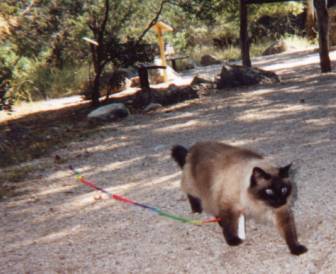|
VACCINE CONNECTED FIBROSARCOMA
A new cancer concern for cat owners is the link between the
development of fibrosarcomas at injection sites. The problem concerning how to safely immunize against such
diseases as Feline Leukemia, Distemper, Viral Rhinotracheitis, Calicivirus and
Pneumonitis to owners and breeders of cats that develop cancer at injection
sites is the cause of current research.
It has been discovered that vaccine connected fibrosarcomas
have a rather low incidence rate from one in 10,000 to one in 1,000 cats
vaccinated. However, the injection
site tumors do spread fast and are poorly defined, which complicates surgery to
completely remove the cancer. These
tumors have been reported to occur from two month to 10 years after vaccination,
leaving owners with the difficulty of connecting a lump to a long past injection
sight.
Commonly used treatment options include surgery, radiation
and new chemotherapy drugs.
These injection site tumors are malignant cancers that
manifest themselves in connective tissues, such as muscle.
They may be movable lumps under the skin or growths that deeply attach to
under lying tissue. A few cats develop multiple tumors at separate vaccination
sites. Owners should be aware of
the risks in order to identify lesions early, when help can be given to
eradicate the tumor.
Recommendations of sites to administer injections have been
changed. It is suggested that
Rabies is to be placed in the bottom part of the right hind limb, feline
leukemia in the bottom part of the left hind limb, and all others in the right
shoulder.
The actual vaccine can cause inflammatory or immunologic
reactions at the vaccine site. The
components of vaccines may stimulate immune cells to produce growth factors that
consequently stimulate cancer cells, which make up connective tissue.
Cancerous tumors form in areas of inflammation produced by vaccines that
contain enhancers that help to improve immune response to the vaccine.
The glitch some with the idea that many vaccines would be ineffective at
immunizing a cat. A solution could be the use of vaccines without adjuvant.
Treatment for cats that develop lumps or growths under
their skin is given by Veterinary Cancer Specialists, who can give aggressive,
multiple treatment procedures. Sophisticated
diagnostic imaging for treatment planning is important in helping to identify
the tumor and define its margins. Any mass located at a vaccine site that
persists for more than three months after vaccination should be surgically
removed. Some of these may be
vaccine reactions rather than tumors. A
biopsy is used to determine whether a cancerous growth is malignant or a vaccine
reaction.
Removal surgery seldom is a total cure and may lead to a
cancer recurrence and even more difficult second surgery.
The results are a 30 to 70 percent recurrence rate.
Surgery is a vital chance for a cure, but even in combination with
radiation, the cure rate is low.
Radiation therapy alone is not recommended, but it can be
used to reduce the tumor size and increase patient comfort. Combining
surgery and radiation has proved helpful in increasing the control rate of the
tumor. Chemotherapy helps to reduce the size of the tumor, and helps with
surgery.
New on the scene of the battle against feline cancer is a
chemotherapy drug called ifosfamide, which is effective in humans.
It has been proven to help cats with injection site cancer. However,
tests are still on going to determine the best way to use it, resulting in
evidence that it could make a major advance in the fight against feline vaccine
site fibrosarcomas. Side effects include the suppression of bone
marrow formation. However, recovery
is usually very fast and the chance of illness is low. Other side effects are
loss of appetite and vomiting.
In humans complications from ifosfamide are kidney and
bladder toxicity. For cats fluids
are given to protect the kidneys and a drug is used to prevent bladder damage.
So far in the study no bladder damage has been seen in any cats.
|

 The
Traditional Cat Association,
Inc.©1987®TM
Official Website
The
Traditional Cat Association,
Inc.©1987®TM
Official Website
